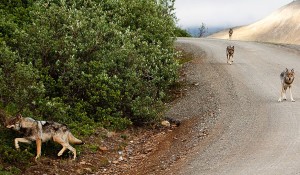DCC Submits Letter in Support of HCR 17

DCC recently sent a letter to Alaska State Representatives Josephson and Kito and the House Resources Committee in support of House Concurrent Resolution 17. We urged the legislature to pass this resolution during this legislative session.
We noted that we strongly support the resolution requesting Governor Sean Parnell to enter into good-faith negotiations with the United States Secretary of the Interior to secure a permanent wildlife buffer conservation easement east of Denali National Park and Preserve. This easement would protect wolves that stray onto state land from hunting and trapping. In return, the federal government would transfer an equal-valued federal easement, property, assets or funds to the State of Alaska.
DCC believes this legislative action is a necessary response to the steep decline in both the number of wolves living in Denali National Park and Preserve and an accompanying decline in wolf sightings by park visitors. The decline in wolf numbers and viewability followed the removal of the Stampede Closed Area in the Wolf Townships in 2010. This “wolf buffer” established by Alaska Board of Game regulation in 2002 prohibited the killing of wolves on state lands west of the Savage River and along the Nenana Canyon. In 2010 (the year in which the state removed the no-take wolf buffer east of the park), wolf-viewing success for the park’s 400,000 visitors was estimated by NPS staff at 45%, declining to 22% in 2011, and then to 12% in 2012. The 2013 wolf-sighting result, released in November by Denali National Park, reflects a further decline, down to just 4%. Such a decline in wolf viewing success is unprecedented.
A single business offering guided predator hunts adjacent to the park boundary takes advantage of park wolves as they cross the park boundary on winter forays onto state lands. Park wolves are easy targets because of their habituation to people inside park boundaries. Liberal bag limits and easy access into the area makes the wolves extremely vulnerable to trapping and shooting.
Economics of Wolf Viewing in Denali
The Alaska Board of Game has been unsympathetic to calls for restoration of the wolf buffer, perhaps because it does not view protection of watchable wildlife as one of its mandates. However, the State of Alaska as a whole clearly benefits from wildlife-driven tourism. Denali is a primary destination for a majority of tourists who travel to Alaska, and is the most important draw pulling tourists away from the coast to the Interior. The major attraction of Denali is the opportunity to see wild northern animals living in their natural habitat, and visitors have a particular interest in predators such as wolves and grizzly bears that are rarely seen outside of Alaska. Denali is one of the best places in the world to see these animals, and was – until recently – perhaps the very best place in the world to see wolves in their natural habitat. Alaskan tourists directly spent 2.42 billion dollars in Alaska during 2012-13.1 By providing protection for park wolves when they cross the park boundary, the state will help to sustain and grow the tourism economy around Denali National Park.
Another consequence of wolf trapping just outside the park is the increase in sightings of wolves bearing trap hardware and injuries. In the winter of 2007- 2008, many people saw one wolf with a gaping throat wound from a broken snare still around his neck. A second wolf with a snare was also seen in the park, as was another wolf with a trap clamped to its foot. Such sightings have a detrimental effect on public opinion of trapping and wildlife management. Additional images of park wolves in traps and snares results in negative press for Alaska and affect the visitor industry.
Benefit to the Ecosystem
DCC’s mission includes protection of the naturally-functioning ecosystem of Denali National Park and Preserve. Such a dramatic removal of wolves by humans undermines the park’s natural ecological relationships, which could have damaging impacts to the wildlife and landscape park visitors come to see. Studies of wolf reintroduction in Yellowstone National Park have documented startling ways in which the influence of predators reaches into the broader ecosystem. Even the dynamics of such apparently unrelated phenomena such as stream bed erosion have changed for the better following reintroduction. DCC strongly believes in the important of a naturally-regulated ecosystem at Denali.
Exchange is in Alaska’s Best Interest
The proposed exchange of a wildlife conservation easement for a like-valued federal property or other asset would benefit Alaska on both sides of the exchange. The wildlife-viewing opportunities at Denali would continue to drive the Southcentral and Interior tourism industry – benefiting many Alaskan businesses and their employees – and the State of Alaska would also receive the direct benefit of the federal property.
Passage of HCR 17 would demonstrate to Governor Parnell and Secretary Jewell that state legislators believe it is important to protect the natural assets that bring visitors to Alaska, and would be a powerful push to initiate negotiations.
See the complete letter attached: DCC letter HCR17-1

